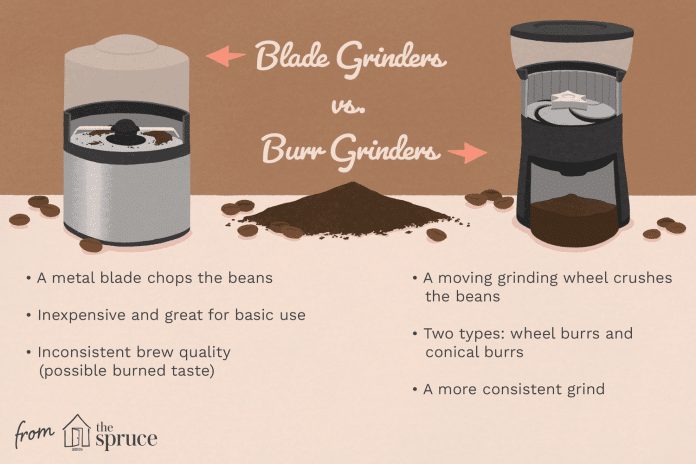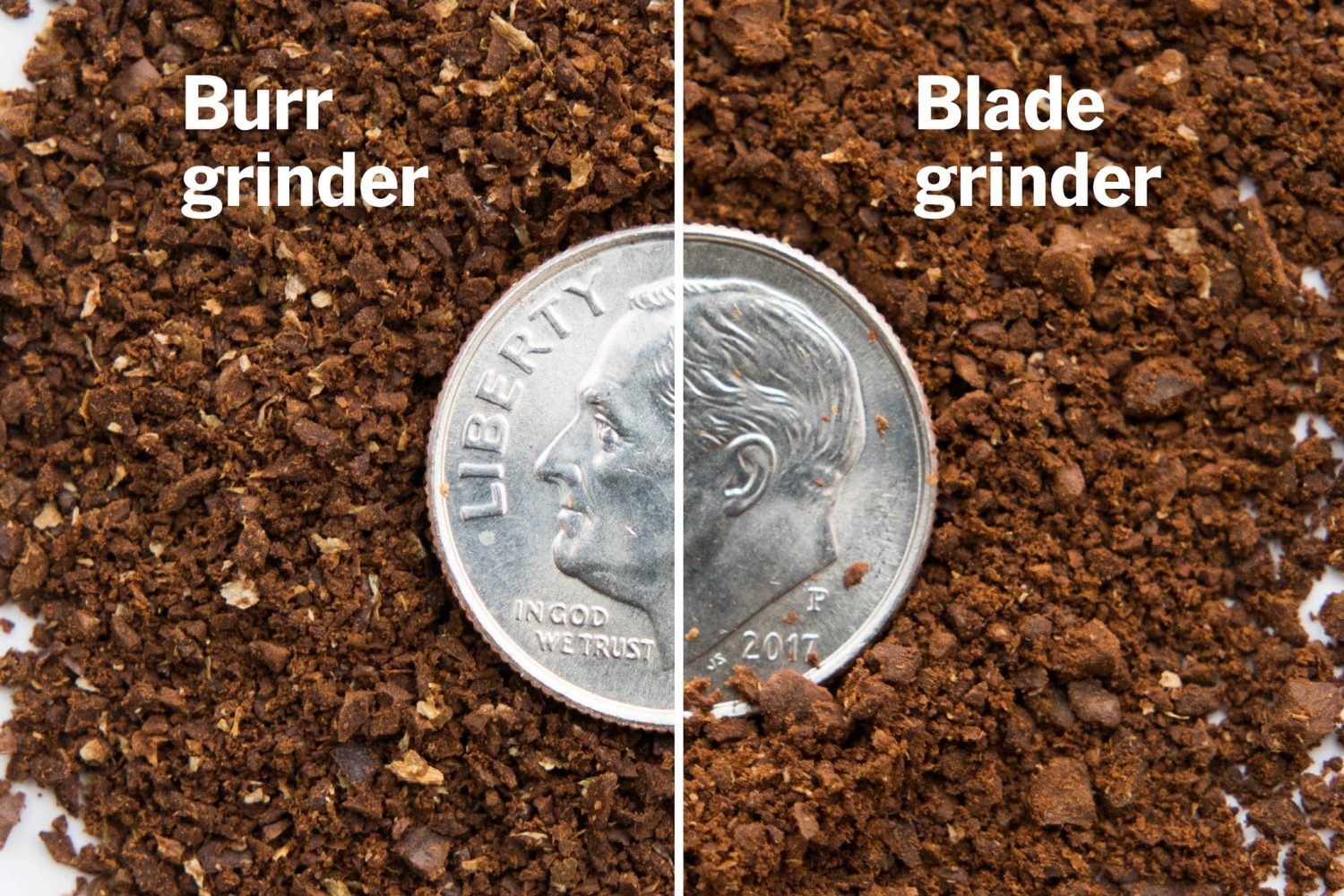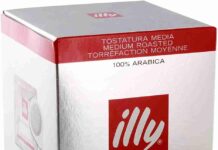There’s nothing quite like freshly brewed coffee to start our day.
But have you ever wondered how your coffee beans’ grind affects your cup’s flavor and aroma? In the world of coffee grinding, there are two main types of grinders: blade and burr.
Each has unique qualities and benefits, so let’s explore which reigns supreme in the battle of blade versus burr.
Blade Coffee Grinders
Blade coffee grinders are popular for many coffee lovers due to their affordability and simplicity. These grinders operate using a mechanism with a spinning blade that chops up the coffee beans into smaller particles. While blade grinders are generally more budget-friendly, it is essential to understand the differences between blade and burr grinders before deciding.
Blade Coffee Grinder Mechanism
The mechanism of a blade coffee grinder is pretty straightforward. Typically made of stainless steel, the blade rotates at high speeds, slicing the coffee beans into smaller pieces. The longer the grinder is operated, the finer the grind will become. This mechanism allows a relatively quick and easy way to grind coffee beans at home.
Grind Size Consistency
One drawback of blade coffee grinders is the lack of grind size consistency. The resulting grind can be uneven since the blade cuts the beans randomly. This inconsistency can affect the extraction of flavors during the brewing process, leading to a less-than-optimal cup of coffee. However, with careful attention and pulsing the grinder, achieving a relatively consistent grind size is possible.
Heat Generation
Another factor to consider when using a blade coffee grinder is the heat generated during the grinding process. Spinning blades at high speeds can create friction, resulting in heat buildup. Excessive heat can cause the coffee beans to lose some flavors and aromas. It is essential to be mindful of this and avoid grinding coffee in large quantities or for extended periods to minimize the heat generated.
Control of Grind
Control over the grind size is somewhat limited with a blade coffee grinder. As mentioned, the longer the grinder is operated, the finer the grind. There is no precise adjustment mechanism to select a specific grind size, making it challenging to achieve consistency when experimenting with different brewing methods. However, with practice and experimentation, finding a suitable grind size for your preferred brewing method is possible.
Noise Level
Blade coffee grinders tend to be on the louder side when it comes to noise level. The high-speed rotation of the blade generates a significant amount of noise, which can be bothersome, especially in the early mornings or if you live in an apartment with noise restrictions. When choosing a coffee grinder, it is worth considering the noise factor, mainly if you prioritize a quieter brewing experience.
This image is the property of www.thespruceeats.com.
Burr Coffee Grinders
Burr coffee grinders are renowned for their ability to provide a more consistent grind compared to blade grinders. These grinders utilize two abrasive surfaces, known as burrs, to crush the coffee beans into a uniform size. While burr grinders are generally more expensive, they offer superior control and precision.
Burr Coffee Grinder Mechanism
The mechanism of a burr coffee grinder differs from that of a blade grinder. Instead of cutting the beans, burr grinders crush them between two burrs, which can be made of ceramic or stainless steel. This crushing action ensures a more consistent particle size, enhancing flavor extraction during brewing.
Grind Size Consistency
One of the key advantages of a burr coffee grinder is its excellent grind size consistency. The precision of the burr mechanism allows for a more excellent range of grind sizes, from coarse to fine. This consistency contributes to more even extraction and produces a better-tasting coffee cup. Whether you prefer a French press or an espresso, a burr grinder can consistently deliver the desired grind.
Heat Generation
Burr grinders generate significantly less heat during the grinding process than blade grinders. The slower rotation of the burrs minimizes friction and heat buildup, preserving the natural flavors and aromas of the coffee beans. This is especially important for those who appreciate the nuances of specialty coffee and want to extract the full potential of their beans.
Control of Grind
Burr coffee grinders offer exceptional control over the grind size. Most burr grinders have adjustable settings that precisely allow you to choose your desired grind size. This flexibility is particularly beneficial if you enjoy experimenting with different brewing methods. Whether you prefer a coarse grind for your French press or a finely ground espresso, you can easily adjust the settings on a burr grinder to suit your needs.
Noise Level
Regarding noise level, burr coffee grinders generally produce less noise than blade grinders. The slower rotation of the burrs combined with their precision crushing action creates a quieter grinding experience. This can be advantageous, especially if you desire a peaceful morning routine or live in a noise-sensitive environment.
This image is the property of cdn.thewirecutter.com.
Factors Influencing Choice
Several essential factors must be considered when choosing between a blade or burr coffee grinder. Understanding these factors will help you make an informed decision that aligns with your preferences and needs.
Price
Price is often a significant consideration when purchasing a coffee grinder. Blade grinders tend to be more affordable compared to burr grinders.
A blade grinder may be a suitable choice if you are on a tight budget or want a primary grinder for occasional use. However, if you are willing to invest in a higher-quality grinder that offers more control and consistency, a burr grinder is worth considering.
Grinding Speed
If grinding speed is your priority, blade grinders generally have an advantage. Their high-speed spinning blades allow for faster grinding, making them ideal for those who need a quick cup of coffee in the morning.
However, it is essential to remember that the speed may come at the expense of grind size consistency. If you value consistency more than speed, a burr grinder is the better option.
Maintenance
Maintenance is an essential aspect of owning a coffee grinder. Blade grinders are relatively easy to clean and maintain. Simply wipe down the blade and exterior with a damp cloth, ensuring no coffee residue is left behind.
Burr grinders, on the other hand, require a bit more attention. The burrs need to be periodically cleaned and, depending on the model, may require calibration or replacement. If you invest time and effort into proper maintenance, a burr grinder can offer long-lasting performance.
Brewing Methods
Your preferred brewing methods should also influence your choice of grinder. Blade grinders may be suitable for brewing methods less sensitive to grind size consistency, such as drip brewing or French press.
However, if you enjoy brewing methods that require precise control over the grind size, such as espresso or pour-over, a burr grinder is highly recommended. The ability to adjust the grind size ensures optimal flavor extraction and a more satisfying cup of coffee.
In conclusion, blade and burr coffee grinders have merits and considerations. Blade grinders are affordable and convenient, but they lack grind size consistency and can generate heat during grinding.
On the other hand, burr grinders offer superior consistency, precise control, and minimal heat generation but at a higher price point. Ultimately, the decision between the two will depend on your budget, brewing methods, and personal preferences.
By understanding the differences and considering the factors influencing your choice, you can select the coffee grinder that best suits your needs and enhances your coffee brewing experience.
This image is the property of cdn.shopify.com.








































